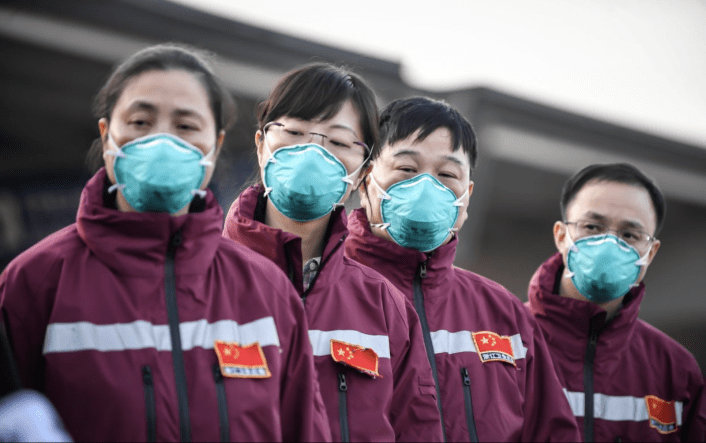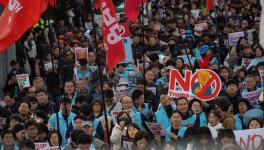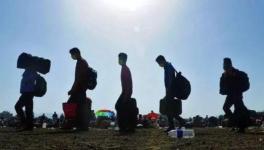China’s ‘Silk Road of Health’ Appears in South Asia

Chinese medical workers in face masks on a deployment overseas.
A virtual meeting of the foreign ministers of China, Afghanistan, Pakistan and Nepal on July 27 becomes the third vector of Beijing’s ‘Silk Road of Health’ diplomacy in Asia.
A Xinhua report on the event said China proposed that the four countries should “consolidate consensus of solidarity against COVID-19, carry out joint cooperation mechanism on COVID-19 response in the region, enhance cooperation in the fight against the pandemic and in vaccine, and accelerate economic recovery and development after the pandemic.”
The foreign ministers of Pakistan, Afghanistan and Nepal conveyed their willingness “to deepen cooperation with China to fight COVID-19, ensure the flow of trade and transport corridors, facilitate people-to-people and trade connection, build a “silk road of health” and community of a shared future for humanity.”
The Silk Road of Health was first publicly mentioned by Chinese President Xi Jinping during a 2016 speech in Uzbekistan. Its first stepping stones are coming into view with the articulation of China’s Covid-19 response under the BRI’s expansive umbrella.
The process began in the Asian region in February with the Special ASEAN-China Foreign Ministers’ Meeting on the Coronavirus Disease 2019 (COVID-19) in Vientiane, Laos. The outcome was encouraging, as the joint statement issued at Vientiane testifies.
Notably, China and the ASEAN found themselves on the same page and agreed on the imperatives of cooperation between the two sides in “preventing and controlling emerging and reemerging infectious and communicable diseases” and to jointly tackle the challenges to protect public health, safety and stimulate the “socio-economic development.”
The ASEAN reposed “full confidence in China’s abilities to succeed in overcoming the epidemic”, while China appreciated the “sympathy, support and assistance offered by ASEAN Member States to its response efforts.”
The Vientiane meeting outlined an action plan, which was fleshed out at another meeting in May at the level of the Economic Ministers. The ASEAN-China Economic Ministers’ Joint Statement underscored an agreement to “further strengthen collaboration at all levels across the region and countries on the prevention and control of COVID-19… (and) facilitating production and access to medicines and vaccines used for the treatment of COVID-19.”
Six weeks later, another Chinese initiative appeared, billed as the China-Central Asia Foreign Ministers Meeting — ‘China+Central Asia’ or ‘C+C5’ with focus on the BRI and emphasising a “joint response” to COVID-19. In comparison with the southeast Asian and Central Asian vectors, the meeting of China and the three South Asian countries on July 27 has been a low-key affair.
China’s priorities in the southeast Asian, Central Asian and South Asian regions vary. Southeast Asia has edged over the other two regions to enter the post-pandemic trajectory.
While the pandemic forced governments across the world to close borders and shut down economic activity, the ASEAN surged as China’s largest trading partner. The increase in trade bears testimony to the region’s unbreakable supply chain with China and the robustness of the linkages binding the Southeast Asian economies with China’s.
This marks a departure from the commonly understood calculus on globalisation. The ASEAN countries do not figure in the world of grand geopolitical narratives. But in the new milieu of the redrafting of the interdependence narratives taking place today, characterised by calls by the US for ending reliance on China-dominated global supply chains and talk of “self-reliance”, etc. — the ASEAN countries have been quick to collaborate with China from the very start of the COVID-19 crisis.
When the US and a clutch of quasi-allies like India and Australia spewed anti-Chinese sentiments in the early days of the infection, the ASEAN countries responded to the distressing news from Wuhan with compassion, solidarity, and unwavering support for Beijing.
The multiple levels of coordinated China-ASEAN response showcases both the necessity and benefits of interdependence and cooperation in times of crisis. Thus, to quote from Marina Kaneti, Assistant Professor at the Lee Kuan Yew School of Public Policy, National University of Singapore, and a specialist on topics of global development,
“With geopolitical and economic pressures exacerbated by the COVID-19 pandemic, countries in Southeast Asia now have the unique opportunity to actively shape a new type of relationship with China: one that is not based on dependence, but instead leverages China’s proposed language of interdependence. Certainly, it is never an easy task to engage China on equal terms. Nevertheless, as Beijing strives to become the leading proponent of multilateralism in the post-COVID world, the parameters and rules of interdependence need not be shaped by China alone. Here, Beijing’s ability to engage with its regional partners can serve as a litmus test to the possibilities and limits of the much-touted vision to “build a community with a shared future.”
In comparison, what the Central Asian countries are seeking is a return of the Chinese economic juggernaut to the steppes. They are reeling under the combined pressures of a slump in commodity prices, a sharp decline in remittances from migrant labourers (usually in Russia which is also suffering the double whack of a major Covid-19 outbreak and a slump in oil prices) and an overall economic slowdown in China.
The economic future of the Central Asian countries is tied to China, thanks to the tyranny of geography. Thus, a fertile ground is available for the return of the BRI to the steppes. Arguably, China’s impressive economic recovery makes this possible.
As a leading expert on Central Asia Raffaello Pantucci noted recently, “China’s infrastructure projects have bound the region together both in Beijing’s considerations and local economic fortunes. This means more BRI is the answer to the downturn.”
On the other hand, it has not escaped Beijing’s attention that the US diplomacy has shifted gear lately in the Central Asian region in the context of the endgame in Afghanistan, which is creating a new security matrix — the 2-decade old Afghan war is coming to an end but a reduced American military presence with strong intelligence capabilities will appear right on Xinjiang’s doorstep for a foreseeable future.
Thus, in his speech at the C+C5 meeting on July 16, Chinese State Councilor and Foreign Minister Wang Yi exhorted his Central Asian colleagues to “step up international cooperation against COVID-19, resolutely oppose the attempts of certain countries to stigmatise and put labels on the virus out of selfish interests, and support WHO in playing its due role in global COVID-19 response.”
Elsewhere, Wang called on the Central Asian countries to “strengthen multilateral coordination and champion fairness and justice.” He added:
“It is important to uphold multilateralism, defend the purposes and principles of the UN Charter, safeguard the UN-centred international system and oppose unilateralism and bullying. Cooperation within multilateral frameworks should be strengthened to promote fairness and justice on the global stage and make international relations more democratic. China and Central Asian countries should render each other firm support regarding sovereignty and security and other core concerns, and jointly uphold basic norms governing international relations and defend the legitimate rights of the six countries.”
According to a Chinese press release, “Wang noted that enhanced cooperation between China and Central Asian countries is a form of mutual assistance between neighbours. It answers the call of the times and benefits both sides and the world beyond.”
“The foreign ministers of Central Asian countries commended China as a close and friendly neighbor, and spoke highly of their strong political trust and ever expanding mutually-beneficial cooperation with China… They praised China’s decisive, effective and successful COVID-19 response… appreciated China’s assistance and expressed the readiness to work with China to promote international cooperation against COVID-19, support WHO’s crucial role and oppose politicisation of the issue.”
The South Asian vector — China plus Afghanistan, Pakistan and Nepal — is relatively subdued in comparison. While Pakistan is Beijing’s traditional ally, Afghanistan and Nepal are newcomers to the Chinese orbit. Pakistan is a flag carrier of the BRI, whereas Afghanistan and Nepal are yet to wet their toes.
While Afghan-Pakistan relations remain extremely fraught, Nepal is a distant neighbour. Clearly, Pakistan, Afghanistan and Nepal do not even make a cohesive sub-region. Beijing could have included Bangladesh, Sri Lanka and Maldives in an initiative over Silk Road of Health but chose not to.
Perhaps, Beijing anticipated that Indians would get excited. Beijing’s interests are three-fold: one, ensure that the US doesn’t spur rumours and create local tensions; two, minimise the impact of Covid-19 on BRI and limit the loss of momentum; and, three, strengthen and re-energise BRI to open up new possibilities in these three South Asian countries where China is universally popular, and medical diplomacy holds the potential to create much goodwill.
Everything adds up for China against the backdrop of the rising US hostility. As Xi framed it last year while addressing a a gathering in Beijing of world leaders who had signed up to BRI, “The ceaseless inflow of rivers makes the ocean deep.” The BRI cooperation is entering a stage of high-quality development and China is determined to make the Silk Road of Health a catalyst for global economic recovery.
Get the latest reports & analysis with people's perspective on Protests, movements & deep analytical videos, discussions of the current affairs in your Telegram app. Subscribe to NewsClick's Telegram channel & get Real-Time updates on stories, as they get published on our website.
























